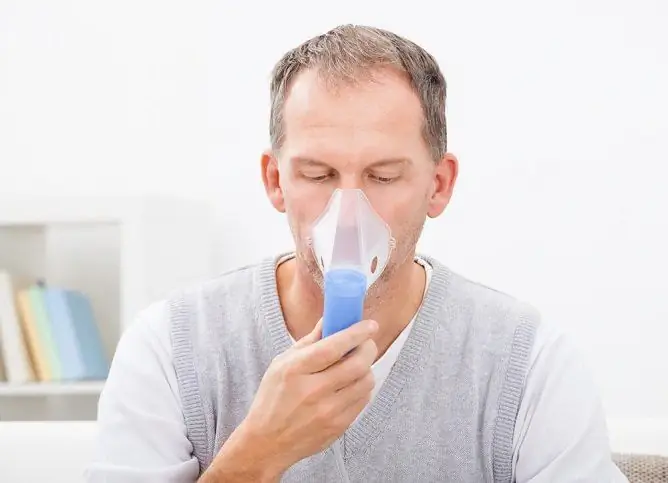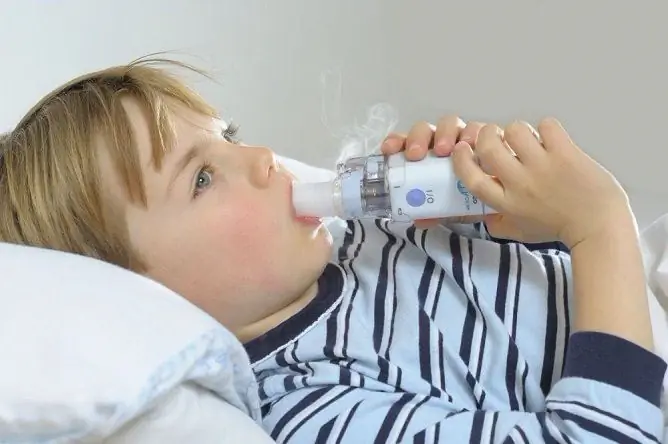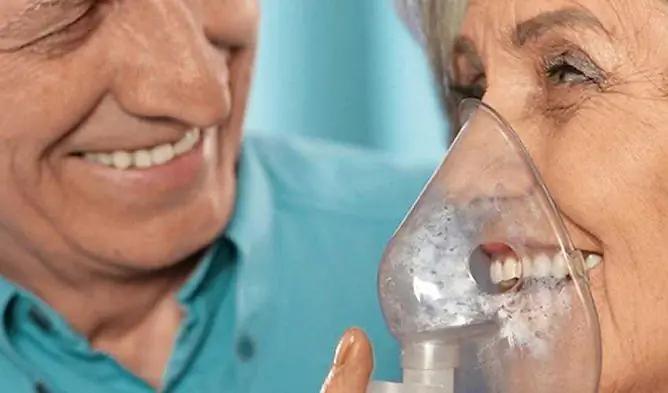- Author Rachel Wainwright [email protected].
- Public 2023-12-15 07:39.
- Last modified 2025-11-02 20:14.
Treatment of sinusitis with a nebulizer: what drugs to use
The content of the article:
- Treatment of sinusitis with a nebulizer
- Contraindications
-
Inhalation with sinusitis with a nebulizer: what medicine is carried out
- Antibiotics
- Antifungal agents
- Glucocorticosteroids
- Proteolytic enzymes
- Mucolytics
- Vasoconstrictor medications, or decongestants
- Biostimulants and phytopreparations
- Inhalation with saline for sinusitis
- Video
Sinusitis, or maxillitis, is an inflammation of the maxillary sinuses of the nose. Inhalation therapy for ENT pathologies has been used since the time of Hippocrates. The first prototype of a modern nebulizer appeared already in the 19th century.
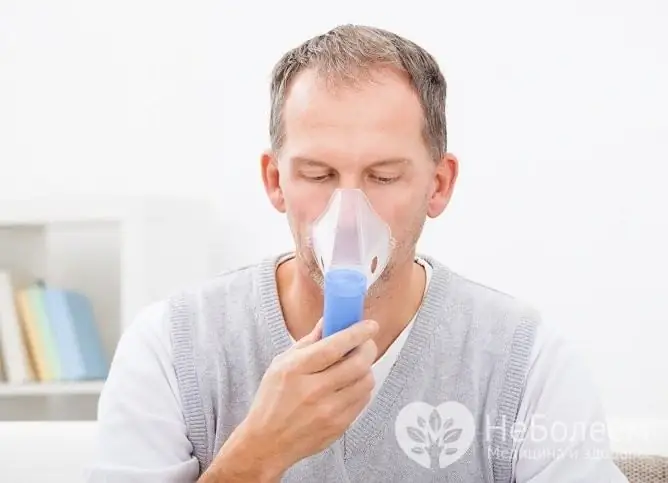
The therapeutic effect of using the inhaler depends on the correct use
Inhalers can be ultrasonic, compressor, pneumatic, steam and heat-moisture. The choice of this or that device depends on the purpose of its use.
In the course of clinical studies, it was proved that the therapeutic effect directly depends on the correct use of the device. The optimum solution temperature is 36-38 ° С. Lower or higher numbers can negatively affect the airway epithelium. For the treatment of inflammatory diseases, it is advisable to use nebulizers. The use of steam inhalers can lead to swelling and atrophy of the nasal mucosa.
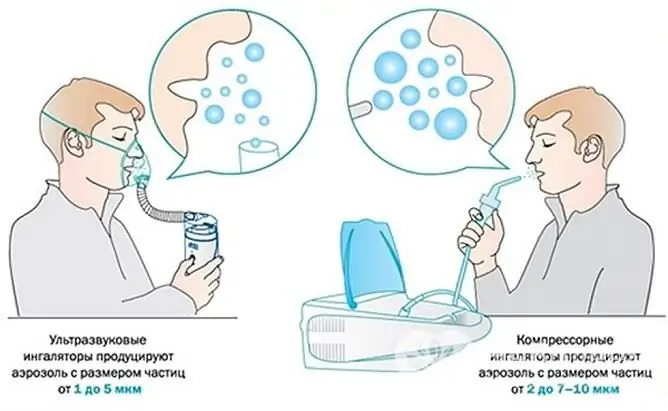
The choice of the type of inhaler is determined by the purpose of its use.
Inhalation devices are divided into stationary and portable. It is optimal to have a portable device at home. There are 2 types of nebulizers: compressor and ultrasonic (US). It was found that a more pronounced therapeutic effect is observed when using an ultrasound device. Its effectiveness lies in its technological features. This type of nebulizer converts the drug into an electro-aerosol. Dispersed particles always have a negative charge, which enhances the anti-inflammatory effect of the active substance. The less dispersion of the aerosol, the deeper it penetrates.
Treatment of sinusitis with a nebulizer
Nebulizer inhalation plays an important role in pathogenetic therapy. The method can be used independently, as well as in combination with other therapeutic measures.
Medicinal aerosols have mucolytic, anti-inflammatory and antiseptic effects. The use of a nebulizer reduces the duration of antibiotic therapy, increases the effectiveness of systemic drugs, and also reduces the risk of adverse reactions.
Oil inhalations are not recommended for sinusitis. Microparticles of oil settle in the most distant parts of the lungs, causing inflammation and necrosis in them.
To avoid the development of side effects, you must follow the rules for the procedure. Inhalation should be carried out 2 hours after meals and physical activity. Before starting the procedure, do not take mucolytics and local antiseptics; you can rinse your nose with saline or boiled water. The nasal mucosa is prepared with vasoconstrictor drops. You must breathe calmly and evenly during the procedure; after its completion, you must not smoke.
Inhalation with a nebulizer for sinusitis therapy is prescribed for 7-10 days. After the end of the course, the patient's general condition improves, the contents of the sinuses are evacuated, and there is also freedom of nasal breathing.
Contraindications
Before carrying out the procedure, it is necessary to check with the doctor whether it is possible to do inhalations with sinusitis with a nebulizer.

In children with a history of allergic reactions, inhalation should be carried out with extreme caution.
Absolute contraindications for inhalation therapy:
- tendency to spasm of the coronary arteries of the heart;
- recent heart attack or stroke;
- bleeding and a tendency to them;
- atherosclerotic lesions of the vessels of the heart and brain;
- bullous emphysema of the lungs;
- spontaneous pneumothorax;
- arrhythmia;
- fever.
A child with a history of allergic reactions should be inhaled with extreme caution. A number of medications can cause bronchospasm and suffocation.
Inhalation with sinusitis with a nebulizer: what medicine is carried out
Antibiotics
Antibacterial aerosols effectively suppress the pathogenic flora in the maxillary sinuses. Before starting inhalation therapy, it is important to exclude allergic reactions to drugs.
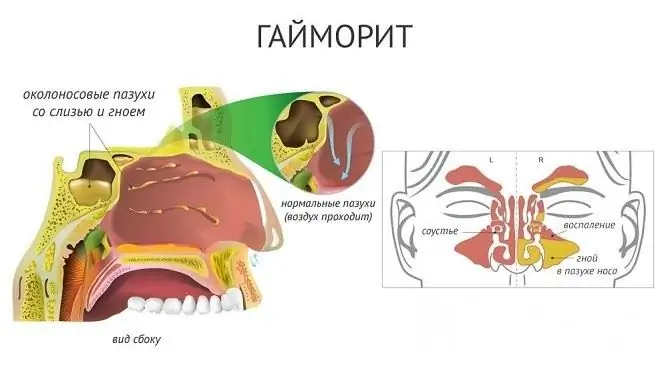
The use of antibacterial aerosols allows you to suppress the pathogenic flora in the maxillary sinuses
Usually 0.01% Miramistin or 1% Dioxidin is used for treatment. Both substances are dissolved in 3 ml of physiological solution (saline).
Fluimucil also has a proven therapeutic effect. In addition, it has a mucolytic effect. Inhalation is carried out 2 times a day. The course of treatment is 5-7 days. The choice of an antibacterial agent is determined by the result of sowing on the flora.
Antifungal agents
Antifungal drugs are prescribed for mycotic lesions of the sinuses. Nystatin is of particular value. It has a pronounced antifungal and anti-inflammatory effect. The drug is prescribed topically, systemic use is irrational.

The use of drugs with antifungal action is indicated for mycotic lesions of the sinuses
The solution for the nebulizer is prepared immediately before the procedure. Take 75 mg of powder (you can grind a tablet) and dilute in one teaspoon of distilled water. The procedures are carried out for adults and children once a day.
If nystatin is ineffective, Levorin is used. The course of treatment lasts up to two weeks. Antifungal inhalations alternate with neutral ones (proteolytic enzymes, saline).
Glucocorticosteroids
This group of drugs has a pronounced anti-edema and anti-inflammatory effect. It is used for diseases with an allergic component.
Hydrocortisone, Dexamethasone and Prednisolone, dissolved in 3 ml of saline, are used as inhalation solutions. The procedures are prescribed 2 times a day for a course of up to 10 days. Glucocorticosteroids severely dry the nasal mucosa. At the same time, it is necessary to do moisturizing inhalations with isotonic solutions.
Proteolytic enzymes
Enzyme preparations have a pronounced anti-inflammatory and mucolytic effect. Enzymes help to liquefy the contents of the maxillary cavities, improving their drainage and aeration.
The product is diluted in saline or distilled water. For treatment can be used: Lysozyme, Trypsin, Chymotrypsin or Chimopsin. Lysozyme also has antiseptic properties.
Enzymes can cause severe allergic reactions. Enzyme inhalations should not last more than 10 minutes.
Mucolytics
Muco-regulating drugs are used to loosen sinus secretions. Mucolytic inhalation improves sinus drainage by freeing the sinus fistula.
The nebulizer pump is filled with 20% acetylcysteine solution. The procedure is carried out 3-4 times a day. A side effect of this drug is irritation of the bronchial epithelium.
When using Fluimucil, additional mucolytics are not prescribed. Ambroxol solution can be used if acetylcysteine is ineffective. However, it has a greater affinity for the bronchial epithelium.
Vasoconstrictor medications, or decongestants
Inhalation with decongestants allows sinus drainage without invasive intervention. Dispersed particles of the active substance penetrate directly into the sinuses, releasing their anastomosis. The general condition of the patient is improving rapidly. The possibility of active nasal breathing appears, as well as the symptoms of general intoxication.
For inhalation, you can use vasoconstrictor drugs of short, medium and long-acting. Currently, drugs with oxymetazoline are prescribed, since it has a prolonged effect (up to 16 hours). This reduces the frequency of procedures.
Oxymetazoline drugs include Nazol, Knoxprey, Nazivin, Rinazolin, etc.
Biostimulants and phytopreparations
Herbal medicines have anti-inflammatory, antiseptic and mucolytic effects. Inhalation can be carried out with aqueous infusions (decoctions) of herbs belonging to the official (recognized, authorized) pharmaceutical preparations.

Decoctions or herbal infusions can be used for inhalation.
Phytotherapeutic recipes for inhalation treatments:
- Ingredients: eucalyptus leaves - 15 g, sage - 20 g, chamomile flowers - 10 g, peppermint - 10 g, pine buds - 15 g, elecampane roots - 20 g, thyme herbs - 10 g. Pour 1 liter of boiling water. Insist 3 hours. The solution is ready to use.
- Ingredients: infusion of medicinal chamomile - 50 ml, aloe juice - 5 ml, Kalanchoe juice - 5 ml, rosehip extract - 5 ml, May honey solution 10% - 5 ml. Mix all components, use immediately after preparation.
Healing herbs stimulate local immunity, and are also effective against pathogenic flora. Phytoncides destroy mucopolysaccharides of the viscous secretion of the sinuses, providing aeration of the cavities. Herbal medicine requires long-term use. The average course is 1-3 months.
Inhalation with saline for sinusitis
NaCl solution (saline) is a unique preparation used for inhalation in otolaryngology. It moisturizes the nasal mucosa and promotes its accelerated regeneration. The saline solution does not have a direct bactericidal effect. However, it stimulates capillary blood flow, increasing the reactivity of local immunity.
In addition, inhalations can be carried out with hyperosmolar solutions, for example, with Hypertonic Humer. Such solutions increase the osmolar pressure in the nasal cavity and sinuses, improving the evacuation of their contents.
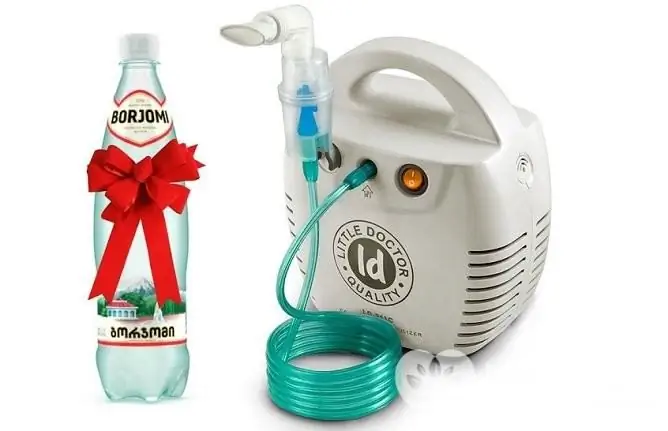
Mineral alkaline water can be used for inhalation, for example Borjomi
Outside of exacerbation, you can do procedures with alkaline mineral water (Borjomi, Essentuki 17). This helps to prevent inflammation and also mechanically clears the nasal mucosa from pathogens. Mineral inhalations are widespread due to positive patient reviews.
Inhalation with sinusitis with a nebulizer is not an alternative to systemic antibacterial and detoxification therapy. In severe forms of sinusitis, surgery is required. The otolaryngologist determines the rationality of inhalation treatment.
Video
We offer for viewing a video on the topic of the article.

Yulia Evtekhova Therapist About the author
Education: Dnepropetrovsk State Medical Academy.
Work experience: Nurse of the Rheumatology Department of Dnepropetrovsk City Hospital No. 11.
Found a mistake in the text? Select it and press Ctrl + Enter.

